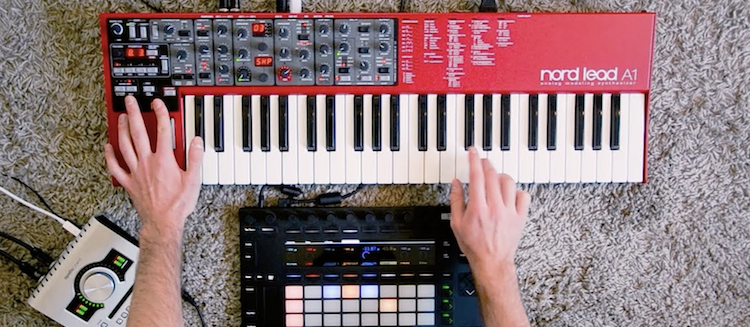My Nord Lead A1 Synthesizer Review

About Nord
Company Details
Clavia Digital Musical Instruments (Clavia DMI AB) is a Swedish manufacturer of virtual analog synthesizers and pianos.
Also known as Nord in North America, the company founded in Sweden in 1983 by Hans Nordelius and Mikael Carlsson.
My Initial Thoughts
In 2013, Clavia, a Swedish virtual analog synthesizer manufacturer, released their Nord Lead 4 synthesizer.
It received largely positive reviews for its many innovations, yet familiar classic design.

While not universally preferred over its predecessors, Nord Lead 4 remained a go-to performance synthesizer of the season.
However, Clavia followed up on the success of Nord Lead 4 with their 2014 model, the latest in the Nord Lead family. We are, of course, talking about Nord Lead A1.
This synth appears as a strong contender to its older siblings.
But how well does it compete against them? Let's start reviewing!
Check the Price on Amazon
- New analog modeling engine with 26-voice...
- Simple yet sophisticated front panel...
- Multi-configurable oscillator, 5-waveform...
Feel, Specifications, Dimensions, and Integrations
As is the standard within the Nord Lead family, the Nord Lead A1 is also a recognizable bright-red with the panel spotting black and grey shades.
It is lighter and smaller than Nord Lead 4, standing at 31.5 x 3.6 x 10.2" and weighing 10.7lbs.
What it also retains from Nord Lead 4’s design is the panel being off-center, which might take getting used to.
The tough casing is back, making this model as durable as all those that came before it.
What is also back, yet not present with Nord Lead 4, are the LED screens for various sections of the control panel.

Yet again we have a Nord standard – a shallow keybed with 49 notes.
Velocity-sensitive and with octave shifting buttons, of course.
And once more, no aftertouch.
Oh, and the 4-part Multi Timbrality for those less-than-simple sounds.
What has changed, then?
Well, 26 polyphony notes, for instance – six more than Nord Lead 4. And an oscillator section which provides you with no less than 47 varying waveforms, but sadly only one LFO.
You effectively have both the traditional analog shapes and digital waves, both harmonic and not.
Memory-wise, Nord Lead A1 obliterates his older brother with eight banks of 50 programs and four banks of 50 performances, or 400 and 200 locations respectively.

Much like Nord Lead 4, A1 also has a Master Clock synchronization option.
And much like Nord Lead 4, it makes layering, splitting and filtering extremely simple and versatile.
Advanced Features and Performance
The first of the three special features unique to A1 is the Like button.
And unlike its Facebook namesake, this one serves an actual useful purpose.
When you do your patch crafting, you can “like” up to 50 variations, which the A1 temporarily stores. This is, admittedly, not a very high number.
You can then browse the “liked” patches, compare them or re-edit them.
At the end, you save the ones you prefer in Nord Lead A1’s memory.

The following feature is the Mutator function. You use the Mutator to vary the patch(es) by modifying any and all elements of it (or them) by a set percentage.
If you prefer to create an entirely new patch with random parameters, use the Randomize mode.
Finally, there’s the Extra Fat Unison Mode.
This grants the A1 the ability to give any vintage analog instrument a run for its money, and is also the feature most users praise the loudest. No pun intended.
Nord Lead A1 is lighter than most Nord models, and just as durable.
Yet, for such a tiny synthesizer it packs a powerful punch.
It seems to incorporate the best options of all its predecessors, with more memory, more polyphony notes and…well, more of everything.
It is, of course, compatible with most music making software, and its connectivity prowess is on par with Nord Lead 4.
Its unique features also make one of the more fun synthesizers out there on the market.
You will have the feeling of literally playing around with sound as you take this bad boy out for a spin.
The quality loss between digital and analog sounds is all but negligible, and the level of synchronization is astounding.
However, if anything makes it stand out in the crowd, it’s the power to go toe-to-toe with other instruments.
The “fat-as-can-be” settings will make short work of them, and give you the edge required to dominate the room musically.
Pros & Cons of Lead A1
Benefits |
|---|
A vast variety of filters and effects |
Light-weight and easy to transport |
Total digital and analogue connectivity |
Drawbacks |
|---|
No LCD screen |
Awkward spacing of the control panel |
Doesn’t have aftertouch |
My Final Thoughts
When you compare it to what came before it, Nord Lead A1 looks, performs and feels better across the board.
26 polyphony notes, 4-part Multi Timbral settings, numerous oscillators, filters, and effects, and a means to toy around with patches before storing them.
Couple that with the ability to rival standard analog instruments and to sync up, split and layer perfectly, and you have a winner.

There is little wonder as to why numerous users hold Nord Lead A1 in high regard.
It will not disappoint, and you will get far more than your money’s worth with this synthesizer.
Check the Price on Amazon
- New analog modeling engine with 26-voice...
- Simple yet sophisticated front panel...
- Multi-configurable oscillator, 5-waveform...
Want to Learn More?
More Links
More Links
More Links

